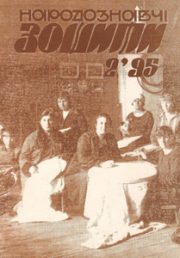The Ethnology Notebooks. 2017, 6 (138), 1584—1590
UDK 72.01
DOI https://doi.org/10.15407/nz2017.06.1584
Received 17.11.2017
DESIGN OF CHILDREN’S PLAYSPASE AS A PART OF THE URBAN INFRASTRUCTURE OF CHINA’S METROPOLISES
Tsiao Shubei, postgraduate student
at the Kharkiv State Academy of Design and Arts.
Mystetstv Street 8, 61002, Kharkiv, Ukraine.
Contacts: Tel. (057) 7060404; e-mail: elena_olenina@mail.ru
Abstract. The article defines the meaning of children’s playspace in the urban infrastructure of China’s metropolises as well as local features of its design. Two main trends in the design of the children’s playspace are identified. Ethnic and traditional national motives are suggested as a possible theme or an image of the design solution. The author has considered standard principles of children’s playspace’s design, which must be used in the implementation of any design idea.
Keywords: design, children’s playspace, urban infrastructure, China.
REFERENCES
Baklyskaja, L.E. (2013). Rekreacionnye prostranstva v spal’nyh rajonah na primere territorii kinoteatra «Habarovsk». Teorіja ta praktika dizajnu,4, 18—25. [in Russian].
Bunin, A.V. (1979). Istorija gradostroitel’nogo iskusstva (Vol. 1). Moskva : Strojizdat. [in Russian].
Vasilenko, N.A. (2009). Sistemnye principy formirovanija landshaftno-rekreacionnoj sredy krupnogo goroda. (Doctoral dissertation). Moskovskij arhitekturnyj institut (Gosudarstvennaja akademija). [in Russian]
Kul’turno-vydovyschni ta dozvillievi zaklady. (2005). Derzhavni budivel’ni normy Ukrainy; budynky i sporudy DBN V.2.2162005. Kyiv : Derzhbud Ukrainy. [in Ukrainian]
Blahoustrij terytorij. Dytiachi majdanchyky. Blahoustrij prybudynkovykh terytorij. (2012). Derzhavni budivel’ni normy Ukrainy; planuvannia ta zabudova mist, selysch i funktsional’nykh terytorij DBN B.2.25:2011. Kyiv : Derzhbud Ukrainy. [in Ukrainian]
Istorija razvitija jekonomiki Kitaja (Vol. 1). (2007). Shanhaj : Shanhaj cajczin dasjuje [in Chinese].
Oleksiienko, A.M. (2017). Produkuvannia etnodyzajners’kykh idej ta tsinnostej v umovakh suchasnoi vystavkovoi praktyky. IV Mizhnarodnyj konhres «Etnodyzajn: poshuky ukrains’koho natsional’noho styli: Poltava-Petrykivka: do 30richchia Spilky dyzajneriv Ukrainy. Poltava.
Sbornik statisticheskih materialov po narodonaseleniju KNR 1949—1985. (1988). Pekin : Chzhungo cajchzhjen czinczi chuban’shje [in Chinese].
Statisticheskij sbornik po KNR. (1991). Pekin : Chzhungo tunczi chuban’shje [in Chinese].
Shuczi, Cao. (2001). Cinskaja epoha. In Istorija narodonaselenija Kitaja (Vol. 5). Shanhaj : Fudan’ dasjuje chuban’shje [in Chinese].
Bikkinin, I.R. Organizacija detskih igrovyh prostranstv v gorodskoj srede sredstvami dizajna. Retrieved from http://www.dom6.ru/19a/44organizatsiyadetskikhigrovykhprostranstv-vgorodskojsredesredstvamidizajna. (Last accessed: 10.09.2017) [in Russian].
Go Pan Fa. (2014). Gosudarstvennyj Sovet po vydache nacional’nyh oblastej bednosti uvedomljaet «Plan razvitija rebenka 2014—2020 ». Retrieved from http://www.fmprc.gov.cn/web/ziliao_674904/tytj_674911/ tyfg_674913/t738182.shtml [in Chinese].
Gorohovodackaja, E.V. (2013, September). Tendencii proektirovanija adaptivnyh rekreacionnyh prostranstv v gorodskoj srede. Arhitekton, 42. Retrieved from http://archvuz.ru/2013_22/63 [in Russian].
Pavlikova, A. Deti v gorode. Retrieved from https://archi.ru/russia/61996/detivgorode (Last accessed: 21.09.2017) [in Russian].
Tretij i chetvertyj svodnyj doklad ob osushhestvlenii Narodnoj Respublikoj Kitaja «Konvencii o pravah rebenka». Retrieved from http://www.fmprc.gov.cn/web/ziliao_674904/tytj_674911/ tyfg_674913/t738182.shtml (Last accessed: 21.09.2017). [in Chinese]
Children in an increasingly urban world. (2012). The State of the World’s Children : report UNICEF. Retrieved from https://www.unicef.org/sowc2012/pdfs/SOWC2012Chapter1Childreninanincreasinglyurbanworld.pdf.
Dobereiner, D. (2015). Matripolis: a green megacity infrastructure. Contribution to the 1st European Urban Green Infrastructure Conference. Vienna. Retrieved from http://www.biotopecity.net/article/ matripolisgreenmegacityinfrastructure
Zippel, E. (2016, September). The Lowline Aims High. Biotope city : international journal, 1. Retrieved from http://www.biotopecity.net/article/lowlineaimshigh






